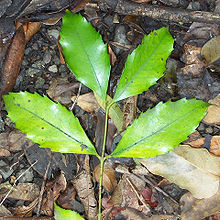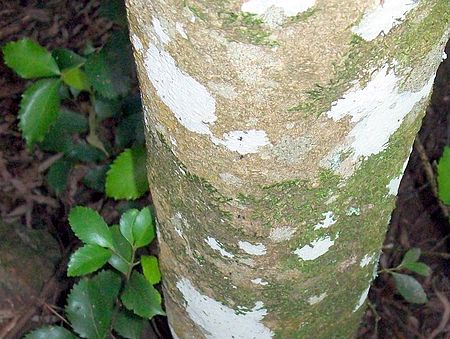- Daphnandra johnsonii
-
Illawarra Socketwood 
Illawarra Socketwood, leaves from a fallen branch Conservation status Scientific classification Kingdom: Plantae (unranked): Angiosperms (unranked): Eudicots (unranked): Magnoliids Order: Laurales Family: Atherospermataceae Genus: Daphnandra Species: D. johnsonii Binomial name Daphnandra johnsonii
SchoddeSynonyms - Daphnandra micrantha (Tul.) Benth. sens. lat.
- Daphnandra species C.
- Daphnandra sp. C sensu Harden (1990) novo-hollandicum
- Daphnandra sp. C Illawarra Schodde 3475
Daphnandra johnsonii, the Illawarra Socketwood is a rare[1] rainforest tree in the Illawarra district of eastern Australia.
Contents
Conservation & Threats
Most of the 41 sites[2] are under immediate threat from clearing for agriculture, urban expansion, feral animals, weeds, inappropriate use of fire and herbicide, quarrying, and road construction.[3] Only two small populations are conserved in the reserve system. The biggest and healthiest populations are on private property.[4]
Habitat
Usually occurring at less than 150 metres above sea level,[5] on volcanic soils in sub tropical rainforest. Occasionally up to 350 metres above sea level.[6] Often by creeks, or dry rocky scree slopes. Also in disturbed forest and rainforest margins. Distributed from Berry, New South Wales in the south to Scarborough, New South Wales in the northern Illawarra (34° S).
Naming & Taxonomy
A member of the ancient Gondwana family Atherospermataceae, the Illawarra Socketwood is endangered by extinction. Formerly considered the southernmost population of Daphnandra micrantha, the Australian Socketwood. Recently it has been recognised as a separate species. The type specimen collected in the Illawarra district by L.A.S. Johnson, after whom the species was named, by Richard Schodde. The generic name Daphnandra refers to a similarity of the anthers of the Bay Laurel. Greek daphne refers to the Bay Laurel, and andros from the Greek for man.[7] The term "socketwood" is from the related species Daphnandra apatela. A feature of which is where larger branchlets meet the main trunk. This joining resembles a "ball and socket" type joint.
Description
A small to medium sized tree. Growing to around 20 metres tall and a stem diameter of 30 cm, with a broad and shady crown. The trunk is beige in colour, cylindrical with little buttressing. Sometimes seen with coppice leaves at the base. The bark is fairly smooth with some raised pustules of a darker colour. Branchlets are fairly thick with lenticels. Wider and flatter at the nodes. Leaf scars evident. Leaf buds with soft hairs.[8]
Leaves
Leaves ovate or elliptic in shape, 6 to 12 cm long, 1.5 cm to 6 cm wide[9] with a sharply angled tip. Leaves are opposite on the stem, prominently toothed, 7 to 9 teeth on each side of the leaf. The bottom third of the leaf is without leaf serrations. The point of the leaf base to the first serration is almost a straight line. The bottom of the leaf is glossy pale green, the top side is a dull dark green.
Leaf venation is more evident under the leaf. Lateral veins not clear on the top surface. Mid rib raised both sides of the leaf. Six or seven pairs of lateral veins. Leaf stems 2 to 7 mm long, and smooth. Old leaves go pale and turn yellow on the stem.
Leaf comparison with Common Sassafras
Leaves similar to the related Common Sassafras, (Doryphora sassafras). There are one or two teeth per centimetre on the Illawarra Socketwood. The mid rib is raised above and below on the Illawarra Socketwood. Lateral veins of the Common Sassafras are at a less acute angle than the Illawarra Socketwood. Illawarra Socketwood lateral veins are sharply angled at around 40 degrees in relation to the mid rib of the leaf.[10]
The scent of the leaf is more faint and "soapy" on the Illawarra Socketwood. Leaves of Common Sassafras are more aromatic, usually less coarsely toothed and the mid rib is sunken on the upper surface.[11] Common Sassafras leaves thicker and heavier to touch.
-
Leaf of Illawarra Socketwood (left), Common Sassafras (right)
Flowers & Fruit
Tiny flowers appear in spring,[12] on long flower stems. Flowers white with pinkish red margins. They form on panicles or racemes, 3 to 8 cm long. The sepals and petals are around 1 to 3 mm. The fruiting capsule is woody and hairless, around 15 to 20 mm long. Opening in two sections. Feathery seeds ripen between August and October.
Regeneration
Healthy seeds germinate readily within a month of sowing.[13]
Plants often don't produce fertile fruit in the wild and these fruit are shorter and rounder than the viable fruit. These short fruit appear to be galled and contain no seed but contain lots of silky hairs or plumes that are normally attached to the seeds. Some trees contain a mixture of both short, galled fruits and long fertile fruits, most trees seem to only produce galled fruits and trees that produce only fertile fruits are rare.[14]
It also has a limited ability to colonize new areas. Its main survival strategy is the ability to sucker and coppice.[15]
References
- ^ government listing: http://www.comlaw.gov.au/ComLaw/Legislation/LegislativeInstrument1.nsf/0/1934B9AB33C1A144CA25753700147714/$file/NamechangesInstrument724.pdf
- ^ http://www.environment.nsw.gov.au/resources/nature/recoveryplanDaphnandraIllawarra.pdf
- ^ http://threatenedspecies.environment.nsw.gov.au/tsprofile/profile.aspx?id=10201
- ^ Anders Bofeldt pers. comm.
- ^ http://plantnet.rbgsyd.nsw.gov.au/cgi-bin/NSWfl.pl?page=nswfl&lvl=sp&name=Daphnandra~sp.+;qu;Illawarra;qu;+%28Schodde+3475%29 access date December 24, 2009
- ^ Anders Bofeldt pers. comm.
- ^ Floyd, A.G., Rainforest Trees of Mainland South-eastern Australia, Inkata Press 2008, ISBN 9780958943673 page 85
- ^ Floyd, A.G., Rainforest Trees of Mainland South-eastern Australia, Inkata Press 2008, ISBN 9780958943673 page 85
- ^ http://plantnet.rbgsyd.nsw.gov.au/cgi-bin/NSWfl.pl?page=nswfl&lvl=sp&name=Daphnandra~sp.+;qu;Illawarra;qu;+%28Schodde+3475%29
- ^ Floyd, A.G., Rainforest Trees of Mainland South-eastern Australia, Inkata Press 2008, ISBN 9780958943673 page 85
- ^ http://plantnet.rbgsyd.nsw.gov.au/cgi-bin/NSWfl.pl?page=nswfl&lvl=sp&name=Daphnandra~sp.+;qu;Illawarra;qu;+%28Schodde+3475%29 access date December 24, 2009
- ^ http://plantnet.rbgsyd.nsw.gov.au/cgi-bin/NSWfl.pl?page=nswfl&lvl=sp&name=Daphnandra~sp.+;qu;Illawarra;qu;+%28Schodde+3475%29 access date December 24, 2009
- ^ Floyd, A.G., Rainforest Trees of Mainland South-eastern Australia, Inkata Press 2008, ISBN 9780958943673 page 85
- ^ Anders Bofeldt pers. comm.
- ^ Anders Bofeldt pers. comm.
- Floyd, A.G., Rainforest Trees of Mainland South-eastern Australia, Inkata Press 2008, ISBN 9780958943673 page 85
- http://plantnet.rbgsyd.nsw.gov.au/cgi-bin/NSWfl.pl?page=nswfl&lvl=sp&name=Daphnandra~sp.+;qu;Illawarra;qu;+%28Schodde+3475%29 access date December 24, 2009
External links
- name change http://www.rainforests.net.au/updates%5Ball-publications%5D/rainforest-trees-shrubs-20091018.pdf
- http://www.environment.nsw.gov.au/resources/nature/recoveryplanDaphnandraIllawarra.pdf
- L.A.S. Johnson http://www.flickr.com/photos/17674930@N07/3992450414/
- alkaloids http://www.publish.csiro.au/paper/CH9782539.htm
- government listing: http://www.comlaw.gov.au/ComLaw/Legislation/LegislativeInstrument1.nsf/0/1934B9AB33C1A144CA25753700147714/$file/NamechangesInstrument724.pdf
- http://threatenedspecies.environment.nsw.gov.au/tsprofile/profile.aspx?id=10201
Categories:- EPBC Act endangered biota
- Atherospermataceae
- Trees of Australia
- Endangered flora of Australia
- Flora of New South Wales
Wikimedia Foundation. 2010.






